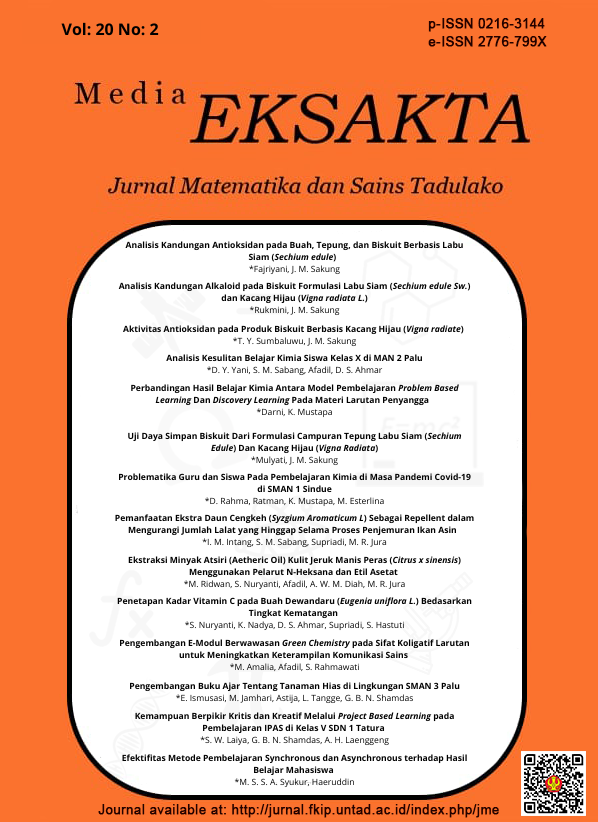Development of Green Chemistry-Informed E-Modules on The Colligative Properties of Solutions to Improve Science Communication Skills
DOI:
https://doi.org/10.22487/me.v20i2.4162Keywords:
E-Modules, Green Chemistry, Science Communication SkillsAbstract
The purpose of this study is to determine the validity of e-modules with green chemistry insights and analyse the effectiveness of using e-modules with green chemistry insights on science communication skills. This type of research is a development method (R&D) with ADDIE development model. The subjects of this research were 33 students of class XII C at SMAN 4 Palu with one group pretest-posttes design. The research data collection technique was carried out using e-module validity test by expert validators, practicality test through learning implementation sheet, questionnaire to measure science communication skills given twice, namely before learning (pretest) and after learning (posttest). The results showed that the validation results obtained from two validators, namely expert lecturers, obtained an overall average of 81% in the valid category. The practicality of the e-module obtained as a whole from 5 meetings is 86.1% which is included in the very practical category. The effectiveness of learning e-modules to improve students' science communication skills is in the large effect category with an effect size d Cohen 0.6.
References
P. Priyono and J. Y. Sinurat, “Communication Dan Collaboration Sebagai Implementasi 4 C Dalam Kurikulum 2013 Di Pondok Pesantren El Alamia Bogor,” Research and Development Journal of Education, vol. 6, no. 2, p. 83, Apr. 2020, doi: 10.30998/rdje.v6i2.6228.
S. Handayani, S. Masfuah, L. Kironoratri, and U. M. Kudus, “Analisis Kemampuan Komunikasi Siswa dalam Pembelajaran Daring Siswa Sekolah Dasar,” Edukatif: Jurnal Ilmu Pendidikan, vol. 3, no. 5, pp. 2240–2246, 2021.
R. Rahayu, R. Rosita, Y. S. Rahayuningsih, A. H. Hernawan, and Prihantini, “Implementasi Kurikulum Merdeka Belajar di Sekolah Penggerak,” Jurnal Basicedu, vol. 6, no. 4, pp. 6313–6319, 2022.
R. F. Turnip, Rufi’i, and H. Karyono, “Pengembangan E-modul Matematika Dalam Meningkatkan Keterampilan Berpikir Kritis,” Jurnal Edukasi Matematika dan Sains, vol. 9, no. 2, pp. 485–498, 2021, doi: 10.25273/jems.v9i2.11057.
F. Wulandari, R. Yogica, and R. Darussyamsu, “Analisis Manfaat Penggunaan E-Modul Jauh Di Masa Pandemi Covid-19,” Khazanah Pedidikan: Jurnal Ilmiah Pendidikan, vol. 15, no. 2, pp. 139–144, 2021, doi: 10.30595/jkp.v15i2.10809.
S. H. Anugerah, Affendy, and Suharti, “Analisis Kesalahan Konsep,” Jurnal Ilmu Pendidikan, vol. 21, no. 2, pp. 178–184, 2015.
Y. Indarta, N. Jalinus, R. Abdullah, and A. D. Samala, “21st Century Skills : TVET dan Tantangan Abad 21,” Edukatif : Jurnal Ilmu Pendidikan, vol. 3, no. 6, pp. 4340–4348, 2021, doi: 10.31004/edukatif.v3i6.1458.
S. Handayani, S. Masfuah, L. Kironoratri, and U. M. Kudus, “Analisis Kemampuan Komunikasi Siswa dalam Pembelajaran Daring Siswa Sekolah Dasar,” Edukatif: Jurnal Ilmu Pendidikan, vol. 3, no. 5, pp. 2240–2246, 2021.
Y. D. Pratiwi, W. Widodo, and W. B. Sabtiawan, “Analisis Komunikasi Sains Peserta Didik Kelas IX Smp Yayasan Pada Masa Pandemi Covid-19,” PENSA E-JURNAL : PENDIDIKAN SAINS, vol. 10, no. 1, pp. 33–36, Jan. 2022.
S. W. Al Idrus, Mutiah, Rahmawati, E. Junaedi, and Y. A. S. Anwar, “Sosialisasi Prinsip Green Chemistry untuk Meningkatkan Kesadaran Akan Bahaya Limbah Kimia Terhadap Lingkungan pada Mahasiswa Prodi Pendidikan Kimia FKIP UNRAM,” Jurnal Pengabdian Masyarakat Sains Indonesia, vol. 3, no. 2, Nov. 2021, doi: 10.29303/jpmsi.v3i2.135.
F. A. Etzkorn and J. L. Ferguson, “Integrating Green Chemistry into Chemistry Education Angewandte,” Angew. Chem. Int. Ed. 2023, no. 62, 2023, doi: 10.1002/anie.202209768.
E. M. Safitri, I. F. Maulidina, N. I. Zuniari, T. Amaliyah, S. Wildan, and S. Supeno, “Keterampilan Komunikasi Siswa Sekolah Dasar dalam Pembelajaran IPA Berbasis Laboratorium Alam tentang Biopori,” Jurnal Basicedu, vol. 6, no. 2, pp. 2654–2663, 2022, doi: 10.31004/basicedu.v6i2.2472.
U. Mahadi, “Komunikasi Pendidikan (Urgensi Komunikasi Efektif dalam Proses Pembelajaran),” JOPPAS: Journal of Public Policy and Administration Silampari, vol. 2, no. 2, pp. 80–90, 2021.
Masyithah, “Penerapan Teknik Keterampilan Sosial Emosional pada Pembelajaran IPA Materi Bioteknologi dan Produksi Pangan Siswa Kelas IX-1 di SMP Negeri 4 Bolo Tahun Pelajaran 2020 / 2021,” JagoMIPA: Jurnal Pendidikan Matemaika dan IPA, vol. 1, no. 2, pp. 135–146, 2021.
H. Aulia and Desmita, “Upaya meningkatkan perkembangan emosional peserta didik dalam proses pembelajaran,” Jurnal Citra Pendidikan (JCP), vol. 4, no. 3, pp. 1960–1967, 2024.
J. P. Islam, A. C. Islam, and H. Indra, “Program pembinaan kematangan intelektual pada siswa SMA,” Tawazun: Jurnal Pendidikan Islam, vol. 15, no. 1, pp. 127–132, 2022, doi: 10.32832/tawazun.v15i1.6822.
E. D. Susanti and U. Sholihah, “Pengembangan E-Modul Berbasis Flip Pdf Corporate Pada Matri Luas Dan Volume Bola,” Range: Jurnal Pendidikan Matematika, vol. 3, no. 1, pp. 37–46, 2021.
I. M. Syahid, N. A. Istiqomah, and K. Azwary, “Model Addie Dan Assure Dalam Pengembangan Media Pembelajaran,” Journal of International Multidisciplinary Research, vol. 2, no. 5, pp. 258–268, 2024, doi: 10.62504/jimr469.
Downloads
Published
How to Cite
License
Copyright (c) 2024 Maryam Amalia, Afadil Afadil, Sitti Rahmawati

This work is licensed under a Creative Commons Attribution-ShareAlike 4.0 International License.
Authors who publish with Jurnal Media Eksakta agree to the following terms:
- Authors retain copyright and grant the journal right of first publication with the work simultaneously licensed under a Creative Commons Attribution License (CC BY-SA 4.0) that allows others to share the work with an acknowledgment of the work's authorship and initial publication in this journal.
- Authors are able to enter into separate, additional contractual arrangements for the non-exclusive distribution of the journal's published version of the work (e.g., post it to an institutional repository or publish it in a book), with an acknowledgment of its initial publication in this journal.
- Authors are permitted and encouraged to post their work online (e.g., in institutional repositories or on their website) prior to and during the submission process, as it can lead to productive exchanges, as well as earlier and greater citation of published work.




